Donald MacLean's Blog 3
THINGS
I seem to be on a roll with "C" things!
In my top page are references to an early home in Clifton, Converting
Censorship into Classification,working in California, Chairing a Cabinet Office Committee, Creating a new Copyright law.
Then the first two blogs are about Change and Communication.
My working title for this one, Nr 3, has been Things until I realised that the things are Cars, Cameras and Computers!
Of course this is simply
Coincidence.
Cars.
A boy thing of course. I've cursed and loved my cars as much as any man but looking at the list of vehicles I've owned it occurs to me that these thirty-six objects are another thread running through my 82 years and each one triggers memories.
As you have come with me this far on my journey I hope you will have twigged that this chapter will not be a paean of praise for big-boy toys, but will use my car list mainly to explore events and people of whom each one reminds me.
During the war my friend Ian Haddow and I played a couple of gigs at a local tennis club and I spent my £5 fee on a car - an MG 'Midget'. It doesn't really count because, having no petrol coupons, I could only sit in the driving seat and dream. It remained on its blocks in the seller's garage for the short time until I needed the fiver more than the dreaming.
A current series of BBC TV programmes called
Top Gear is immensely popular. It is, of course, about cars (and about driving them) (fast) and if I was still in TV I would probably be proud to be its producer. But I hate it. I try to watch when it deals with something that I want to understand the development of non-polluting engines, for example but then a presenter intrudes his inflated personality, (So let's burn rubber) and I switch off, growling, like every other grumpy old fart.
My successors in TV need to turn everything into a story. They rarely let we viewers hear someone's words, notice their body-language, and make up our own minds. They're too often concerned with projecting their own personality rather than their subjects'.
My successors in Radio (do Radio Producers still exist?) increasingly allow presenters to run one sentence into the next - a habit that is spreading like an epidemic across the English-speaking world. They should be reminded that punctuation was developed for sound practical reasons.
I'm told I was the first student (maybe also the last) to gain a Scottish Higher Leaving Certificate with only 18% for Latin (being marked in the nineties for English, French and Music may have mitigated) but even I know the derivation of "ie" and "eg". Recent generations clearly do not these handy abbreviations became interchangeable - and then settled the wrong way round! 'ie' now more often means 'for example'.
Similarly several plural words are becoming singular 'media' is a frequent example.
You will notice that I have scant respect for some academic rules of grammar (
not starting sentences with 'And ...' for instance) my criterion is always the practical matter of effective communication.
HARRUMPH! Where was I?
I'm in the back of a rather upmarket car, in the seventies, listening to the boss of a major publishing empire, as we head for his printing works near Glasgow. He is waxing lyrical about the new-generation machinery I'm about to see. I haven't travelled this road for almost three decades but it is familiar ...
1950. I've just been appointed junior producer at Broadcasting House in Glasgow. Margaret and I have moved from Aberdeen to lodge with her kind mother in her house in the little town of Kirkintilloch, about 8 miles East of Glasgow.
The road outside Kirky descends a long steep hill before crossing the Forth & Clyde canal on a very narrow bridge at a sharp angle bored drivers of double-deck buses delight in accelerating down the hill and swerving through this chicane with the bus leaning perilously to the right then lurching suddenly to the left. I am often the sole passenger ... and I can see why!
Each journey to and from the studios involves also an unpleasant stint on the dank-smelling subway and a 10-minute walk from Kelvinbridge station.
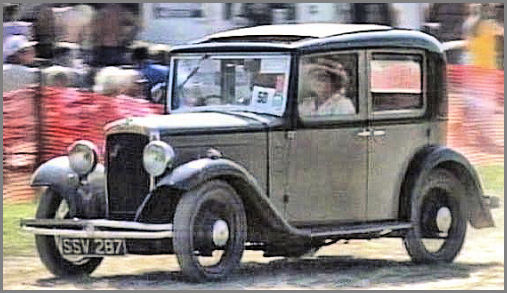 |
|
1932 Austin 10 (much smarter than mine) |
So I buy my first car an 18 year-old Austin 10. The wooden framework of the nearside body is starting to rot, so I bolt that door to its frame (entry to the passenger seat is possible but only via the driver's door). Like most cars of the early thirties both the acceleration and braking can be described as, well, leisurely. However nobody laughs as I proudly leave it in my parking space in Queen Margaret Drive.
One wintry day, en route, I skid on the icy road and slide, all wheels locked, towards a stationary bus. Realising I'm going to hit it, and calculating that the queue of passengers is almost fully boarded, I bump up onto the pavement and come to a stop abeam the cab of the grinning driver and at the feet of a tall policeman!
In a gentle Highland voice he asks Sir to step outside, puts two large hands on the roof and rocks the car firmly on its springs. Whatever this tells him is clearly not good news. To my relief he doesn't try to open the other door and he smiles paternally as he advises me to start saving for a replacement vehicle. (How different the 21st century world?)
In the upmarket limousine I haul myself back into the present and say
How very impressive which fortunately appears to be appropriate to whatever my host had been saying.
The Austin is followed by three car-less years the last such.
My next purchase is a small & decrepit '33 Morris 8 which for two years transports me regularly from our home in Harlow to my parents' Elizabethan house in Great Dunmow where my father is sadly reaching an untimely end to his days. In the cold winter of '54 I invest £5 at Halfords for an interior heater for the Morris. By modern standards it is grossly ineffective but at the time seems luxurious.
We move to Bishops Stortford, to a house which Margaret loves. It has a little stream running down the side of the garden. I used to have a photograph of 4-yr-old Colin smiling down from the branches of an apple-tree with, alongside him, his friend Nicky whose mischievous grin identifies him immediately as the grandson of Sir Malcolm Sargent, Margaret's one-time mentor (and hero) at the Royal Academy of Music.
A 2-year period follows during which I have a sedate pre-war Rover (I spend most of '56 recalled to the army, in Wiltshire and Egypt. The subject of a blog-to-come.)
My vintage car phase starts in '58 with my first Bentley a 1929 3-litre tourer which I buy from the conductor of the BBC Revue Orchestra, Paul Fenoulhet. In the thirties it had been refitted with an elegant light-blue aluminium body a piece of cosmetic surgery sniffily disapproved by the Bentley Drivers' Club.
Last Saturday Ann and I visited a longtime (film producer) friend, now in a nursing-home in the depths of Buckinghamshire, and we passed the road which used to be the scene of an annual hill-climb competition for sports cars. This was the first event assigned to me as an 'outside broadcast' producer by Peter Dimmock. My parked Bentley was always surrounded by admiring spectators who probably didn't know that if it had competed it would have reached the top of the hill slowly and in a cloud of steam. (Mr W.O. Bentley eschewed cooling fans his cars being intended to move rapidly along open roads, not lumber up 1:5 rural gradients.)
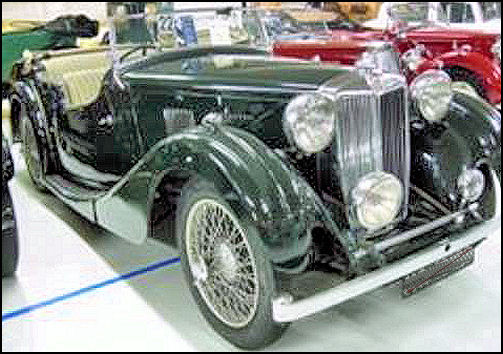 |
|
1938 MG VA 1.5 Tourer |
A 1938 1.5 litre MG tourer follows. Bought second-hand jointly with my friend Geoff Owen (later to become Controller of BBC's Radio 2). When Geoff and Pauline marry they spend their honeymoon touring Europe in EEL 740.
In 1959 I receive a phone call asking if I might be interested in acquiring a wrecked 1926 car being used as a hen-house on a Yorkshire farm. When the caller says it's a Rolls Royce 20 with a 'soft-top' body (and is exactly the same age as me) I succumb.
I have to get a specialist to replace the cogs round the huge flywheel (with which the starter engages) an interesting process involving heating the cogs while freezing the flywheel. Otherwise I laboriously strip the beautiful machinery, clean & reassemble it. Every item is meticulously designed, including an ingenious power-assisted braking system. The soft sound of this engine running is a symphony of quiet clicking.
Margaret's mother is now in failing health and has come to live with us. For several winter months, while we wait for the specialist upholsterer to create seating and folding roof, the two ladies gallantly suffer being driven around Hertfordshire sitting rug-wrapped in wicker chairs, placed in the vast empty space of the open body, with a Valor oil stove between them.
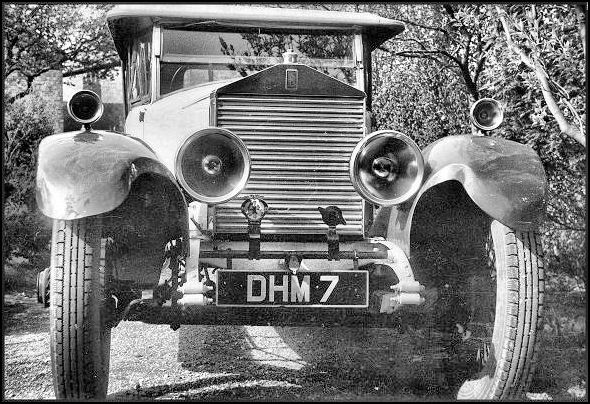 |
|
Renovated hen-house: 1926 Rolls Royce "Twenty", touring coachwork by Watson. |
I think this eccentric mode of transport amuses Mrs Thorburn, but her shy daughter plainly hates being so conspicuous. To reduce my guilt I buy Margaret, in 1960, an elderly Hillman Minx. For the Rolls I obtain the registration DHM 7 (my initials & lucky number). This costs me one phone call to a nice clerk in West Ham and a cheque for £5 for a registration now valued at exactly a thousand times that sum.
I telephone Rolls Royce in Crewe and give the chassis number to an elderly clerk who goes to the 'cubby hole' for this particular car, extracts its reserve leather-bound Instructions for Your Driver and posts it to me. He says this chassis was delivered, on the purchaser's instructions, to a coachbuilder in Liverpool called Watson.
The following year this genteel old lady goes to a cosseted retirement in New England (still wearing 'my' plates) and is insured for two million dollars.
The Rolls is replaced by a raunchy twenties jezebel another 3-litre 'Red Label' Bentley, this one from 1925 and completely original (and therefore approved in Long Crendon). It needs enough TLC to ensure that my finger-nails retain their coal-miner appearance (and Gresolvent perfume) for another year.
One Sunday afternoon, more than 40 years later, we are driving back into the village (in our Volvo estate) when Ann says Is the vintage car parked outside that house like the old Bentley you talk about ... what was its number? Ah I sighed, My lovely BO.9239. That said Ann is BO.9239!
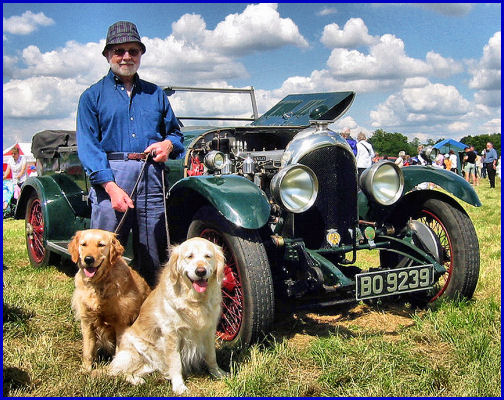 |
|
Friends reunited! Beckie & Kirstie bored. |
BO.9239 has a 'straight-through' exhaust that was already illegal for all but vintage sports cars a 4 diameter copper pipe like the diapason of a cathedral organ and with a similarly majestic sound.
My friends load their MP3-players with the latest hits mine includes a 5-minute drive on country roads 50 years ago in BO.9239 with a tape-recorder bouncing on the back seat at 60mph.
To Ann it sounds like a noisy old banger. To me it is a basso-profundo solo of utterly mystical quality.
You judge - here's a 68-second sample (accelerate to 60mph X decelerate to stop):
No flash player!
It looks like you don't have flash player installed. Click here to go to Macromedia download page.
And so, driving my 34th car, I was reunited with my 8th how enormous must be the odds against this coincidence? BO lives happily on the other side of the village and its kind owner allows me nostalgic wallows.
Seven of the 35 cars appear on my list as debutantes - in the year of their launch. I bought one of the first Triumph Mayflowers (in which I explored the Loire Valley and acquired a lifelong taste for cold Vouvray, the nearest thing to nectar in the real world). A white Triumph Spitfire, a Hillman Imp (in which we discovered the other-world of SW Ireland where drivers halt in the middle of single-lane bridges, stopping the traffic for 5 minutes while they savour the view).
In 1965 Rover brought out a curvy new-generation '2000' which took us on a midwinter holiday to Geoff and Pauline's house in the South of France. Wherever we parked it an interested audience would gather. An excited 11-yr-old Colin and I joined the 'ton-up' club on the Haute Corniche when mummy wasn't with us.
Margaret's cars, following the Minx, were a green Mini, the aforementioned Imp, a little Renault and, her last car, a Fiat Strada automatic.
Geoff had become one of my three deputies (responsible
for 'middle-of-the-road' music) and it was on his advice that I bought a
second-hand Daimler-Jaguar.
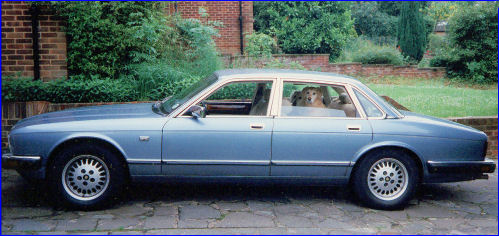
And when I signed a management contract with EMI, car-providing (and maintenance) passed to an expert Transport Office and it was in comfortable Jags that I shuttled between home and offices and airports for the next 13 years, usually digesting legal and financial documents under the reading light in the back.
In retirement Ann and I kept our final company car, this blue Jaguar Sovereign. However a £400 bill for one new tyre sent us back to our budgeting and after a year it was replaced by a just-launched Honda Concerto, followed by a couple of VW Golfs then 4 Volvo estates in succession (partly as transport for two Golden Retrievers).
Thirty years ago I was citing spreadsheets as an example of a benefit unique to computers. My car list is actually one of my first spreadsheets created at the time, on one of my first serious Computers.
Which will lead us to some other C things, including meetings of the first dozen owners of Apple computers, and why two of my exhibition photographs (of an owl & a pussycat) hang in Vera Lynn's house.
D.H.M.
"I spent a lot of money on booze, girls
and fast cars.
The rest I squandered."
George Best
- - - - - -
Back to 'Contents' table
On to Blog 4
- - - - - -